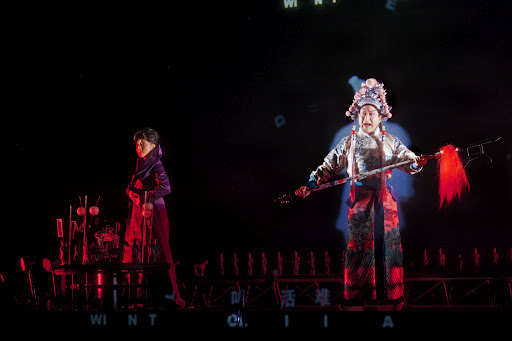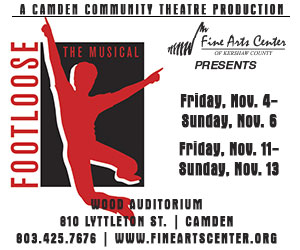
My Spoleto weekend wrapped up with a tour of music spanning many centuries and the entire globe. The trip went from ancient China to 1790s London, to 19th century New England, and May 2012 Japan. And I was able to do it all in a 10 block area of downtown Charleston between 11 a.m. and 8 p.m. Sunday.
Let’s start in the oldest and last stop – which also has the benefit of being very new.
The opera Feng Yi Ting by Duo Wenjing had its first full production and American premiere in Charleston Sunday night. It’s based on a tale from the Han Dynasty (206 BC – 220), but was written in 2004 and brings together musical and theatrical elements from both ends of that time frame. In the story, the despotic leader of the country has recently adopted a new godson. A young woman, Diao Chan, decides to seduce them both to set them against one another allowing for for more sensible leaders to take charge. The story is told with humor and beauty, but this is no epic – it has only two performers (the young woman and the godson) and lasts barely 45 minutes.
What makes it unique is the blending of Eastern and Western music and opera styles. In the pit of the Dock Street Theatre along with the violins and oboes are several musicians playing traditional Chinese instruments. On stage the performers sing and act in the highly mannered style of Chinese opera, while surrounded by state-of-the-art video projections as well as live video feed of the actors in giant black and white close ups. It sounds like it could be a mess of too much, but it isn’t.
The highly-praised composer’s music is always engaging and the quality of this production shouldn’t be a surprise considering the rest of the team working that created it. The director is Atom Egoyan (best known for his many movies including The Sweet Hereafter) and Derek McLane, a Tony-winning Broadway designer.
For some audience members an hour of the Chinese opera style singing is probably plenty. But we did 15 hours of the 18-hour Chinese opera The Peony Pavilion at the festival a few years ago. Another hour of something as imaginative and excellent as Feng Yi Ting would have been fine with us.
Additional performances take place May 29, June 1, 4 and 7.
A few hours before the trip to ancient China we were in Japan in 2011 – when the earthquake and tsunami struck. The first concert in the Music in Time series, which focuses on contemporary classical, brought to the hall three works by prominent Japanese composers many of us have never heard of. All the works were written for traditional Western instrumentation and one would be hard pressed to find anything particularly “Japanese” about the music.
The program had a very last minute change when composer Toshio Hosokawa called series director John Kennedy a few weeks ago and offered a brand new piece instead of the one scheduled – and it turned out to be a work about the disaster in Japan, as was the piece by Toshi Ichiyanagi that was the linchpin of the concert. The new work, Meditation, had its world premiere in Korea just a few weeks ago; the festival didn’t even receive the music until five days before the concert.
The lateness of the addition showed in no way. This is an intense and dramatic work that musically reflects the power of the earth to shift, move and heave land and water at will. It calls for 30 players which made for a very packed stage at the College of Charleston recital hall and a roar of sound always. The first movement is called Beat of the Earth and that beat, aided by ample percussion is the thing that marches forward through Meditation.
Ichiyanagi, the most distinguished senior composer in Japan, wrote his Symphony No. 8 – Revelation 2011 less than a year after the earthquake, tsunami and resulting death and damage to a nuclear power plant and the Sunday concert was the American premiere. Like Hosokawa’s piece, this one is very much about the power of the earth – how it can kill and how it can heal. Although the ensemble was slightly smaller at about 20 it is still a loud and dramatic piece, but had the benefit of many passages where several young players from the festival orchestra shone as soloists.
The final piece, Listening to Fragrances of the Dusk by Somei Satoh, was also getting its American premiere at the concert. Although written in 1997 long before the disaster, it seemed to be speaking to the tragedy as well. Unlike the two other pieces this is a very quiet, slow and meditative work – and served as a perfect elegy for the victims and coda for the concert.
The second offering of the chamber music series served up what series organizer and host Geoff Nuttall described as a “Haydn sandwich” – the Haydn Symphony 101 between works by late 19th and early 20th century American composers Arthur Foote and Amy Beach. Both of the Americans were from New England and their music, especially that of Foote, felt like a stroll through the New England countryside on a summer day with Beach’s Piano Quintet in F sharp minor being the more dramatic of the strolls. “This is some of the most amazingly exquisite music you’ve never heard before,” Nuttall said, and he was right.
Nevertheless, it wasn’t Haydn.
The Symphony 101 was one of the composer’s famous London Symphonies which were amazingly popular and heaped with praise for very good reason. Wanting to spread the music further than a full orchestra could take it, and there being no MP3 players at the time, the symphonies were arranged for smaller ensembles. In this case the work was played by the St. Lawrence String Quartet with the addition of flute, piano and double bass. I’ve heard dozens of these chamber concerts over the past 20 years and the performance of the Symphony 101 Sunday was in the top 10. The players took this work, which is full of sections in which the musicians appear to be searching for the right music, to new heights. Haydn loved to create these quirky pieces that played with, but eventually delighted and astounded audience members. This symphony did so in the 1790s and it did the same on a May Sunday in 2012.
At the end of the work, the musicians appeared ever happier than the audience. I don’t think I’ve even seen a group of players who appeared more thrilled with what they had just done. I thought they were about to levitate, but believe they already had.
– Jeffrey Day







.jpg)